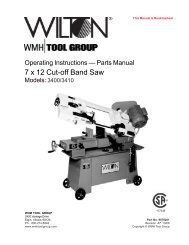This Rigger's Handbook is dedicated to Theodore C - Igor Chudov
This Rigger's Handbook is dedicated to Theodore C - Igor Chudov
This Rigger's Handbook is dedicated to Theodore C - Igor Chudov
Create successful ePaper yourself
Turn your PDF publications into a flip-book with our unique Google optimized e-Paper software.
YOUR SLING AND RIGGING SPECIALIST<br />
SLING AND HOIST HOOKS<br />
WARNINGS AND APPLICATION<br />
INSTRUCTIONS<br />
S-319 S-320 S-320N S-322<br />
Important Safety Information –<br />
Read and Follow<br />
• A v<strong>is</strong>ual periodic inspection for cracks, nicks, wear,<br />
gouges and deformation as part of a comprehensive<br />
documented inspection program, should be conducted by<br />
trained personnel in compliance with the schedule in ANSI<br />
B30.10.<br />
• For hooks used in frequent load cycles or pulsating loads,<br />
the hook and threads should be periodically inspected by<br />
Magnetic Particle or Dye Penetrant. (Note: Some<br />
d<strong>is</strong>assembly may be required.)<br />
• Never use a hook whose throat opening has been<br />
increased, or whose tip has been bent more than 10<br />
degrees out of plane from the hook body, or <strong>is</strong> in any other<br />
way d<strong>is</strong><strong>to</strong>rted or bent. Note: A latch will not work<br />
properly on a hook with a bent or worn tip.<br />
• Never use a hook that <strong>is</strong> worn beyond the limits shown in<br />
Figure 1.<br />
• Remove from service any hook with a crack, nick, or<br />
gouge. Hooks with a crack, nick or gouge shall be repaired<br />
by grinding lengthw<strong>is</strong>e, following the con<strong>to</strong>ur of the hook,<br />
provided that the reduced dimension <strong>is</strong> within the limits<br />
shown in Figure 1.<br />
• Never repair, alter, rework, or reshape a hook by welding,<br />
heating, burning, or bending.<br />
• Never side load, back load, or tip load a hook. (See Figure<br />
2)<br />
• Eye hooks, shank hooks and swivel hooks are designed <strong>to</strong><br />
be used with wire rope or chain. Efficiency of assembly<br />
may be reduced when used with synthetic material.<br />
• Do not swivel the S-322 swivel hook while it <strong>is</strong> supporting<br />
a load.<br />
• The use of a latch may be manda<strong>to</strong>ry by regulations or<br />
safety codes; e.g., OSHA, MSHA, ANSI/ASME B30,<br />
Insurance, etc.<br />
• Always make sure the hook supports the load. (See Figure<br />
3) The latch must never support the load. (See Figure 4)<br />
• When placing two (2) sling legs in hook, make sure the<br />
angle from the vertical <strong>to</strong> the outermost leg <strong>is</strong> not greater<br />
than 45 degrees, and the included angle between the legs<br />
does not exceed 90 degrees.* (See Figure 5)<br />
• See ANSI/ASME B30.10 "Hooks" for additional<br />
information.<br />
*For two legged slings with angles greater than 90°, use an intermediate<br />
link such as a master link or bolt type shackle <strong>to</strong> collect the legs of the<br />
slings. The intermediate link can then be placed over the hook <strong>to</strong> provide<br />
an in-line load on the hook. <strong>Th<strong>is</strong></strong> approach must also be used when using<br />
slings with three or more legs.<br />
HEADQUARTERS: 55 James E. Casey Drive • Buffalo, NY 14206 PHONE: 716.826.2636 FAX: 716.826.4412 www.hanessupply.com<br />
87<br />
Sling and Ho<strong>is</strong>t Hooks<br />
• Loads may d<strong>is</strong>engage from hook if proper<br />
procedures are not followed.<br />
• A failing load may cause serious injury or<br />
death.<br />
• See OSHA Rule 1926.550(g) for personnel<br />
ho<strong>is</strong>ting by cranes or derricks. A 319, 320 or<br />
322 hook with a PL Latch attached (when<br />
secured with the bolt, nut and pin) may be<br />
used for lifting personnel.<br />
• Threads may corrode and/or strip and drop<br />
the load.<br />
• Hook must always support the load. The<br />
load must never be supported by the latch.<br />
• Never apply more force than the hook's<br />
assigned Working Load Limit (WLL) rating.<br />
• Read and understand these instructions<br />
before using hook.<br />
ZONE B<br />
RIGHT<br />
45° 45°<br />
60°<br />
ZONE A<br />
2/3<br />
ZONE C<br />
WARNING<br />
ZONE A: REPAIR NOT REQUIRED<br />
ZONE B: 10% OF ORIGINAL DIMENSION<br />
ZONE C: 5% OF ORIGINAL DIMENSION<br />
ZONE D: SEE MINIMUM THREAD SIZE<br />
Side Load Back Load<br />
WRONG<br />
Tip Load<br />
WRONG<br />
Figure 1<br />
Figure 2<br />
ZONE A<br />
Figure 3 Figure 4 Figure 5<br />
ZONE B<br />
45° 45°<br />
2/3<br />
ZONE C<br />
60° ZONE D
















